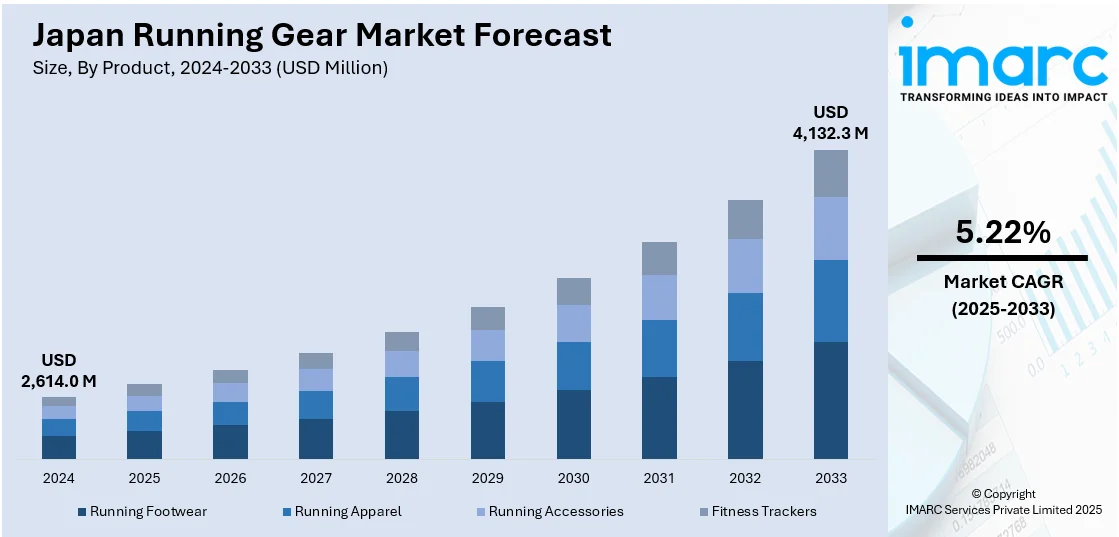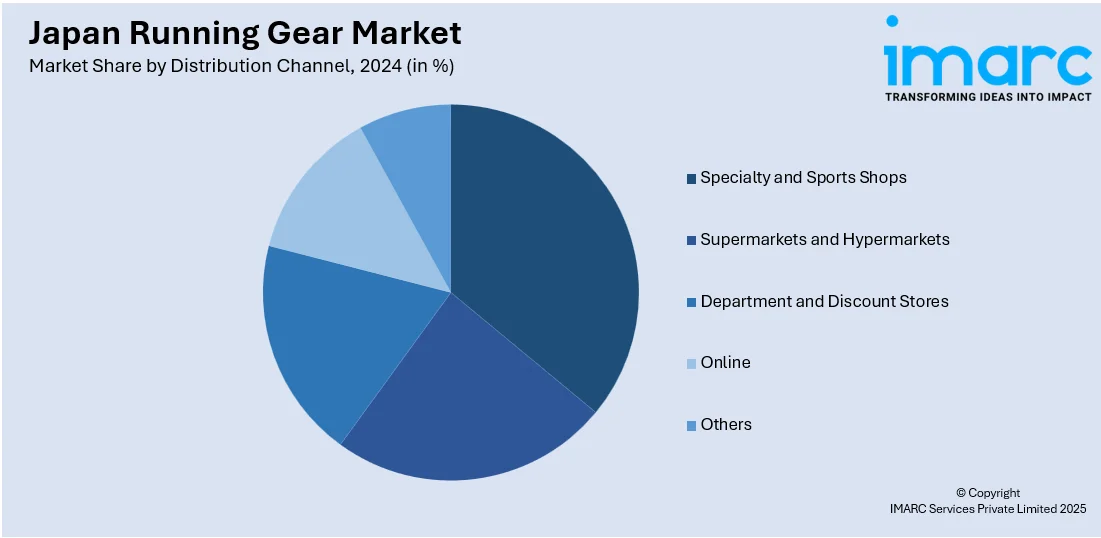
Japan Running Gear Market Size, Share, Trends and Forecast by Product, Gender, Distribution Channel, and Region, 2025-2033
Japan Running Gear Market Overview:
The Japan running gear market size reached USD 2,614.0 Million in 2024. Looking forward, IMARC Group expects the market to reach USD 4,132.3 Million by 2033, exhibiting a growth rate (CAGR) of 5.22% during 2025-2033. The market is growing due to increasing fitness awareness, innovation in performance footwear, and cultural pride in endurance sports. Continuous product advancements and strong domestic brand loyalty are driving demand for high-comfort, high-tech shoes and apparel tailored to both casual and professional runners.
|
Report Attribute
|
Key Statistics
|
|---|---|
|
Base Year
|
2024 |
|
Forecast Years
|
2025-2033
|
|
Historical Years
|
2019-2024
|
| Market Size in 2024 | USD 2,614.0 Million |
| Market Forecast in 2033 | USD 4,132.3 Million |
| Market Growth Rate 2025-2033 | 5.22% |
Japan Running Gear Market Trends:
Cultural Endurance Influences Innovation
Running holds deep cultural value in Japan, particularly through traditions like the Ekiden, a long-distance relay race that symbolizes dedication, endurance, and teamwork. This tradition continues to shape the country's demand for running gear, where performance meets symbolism. In November 2024, Nike launched its 2025 Ekiden Collection in Japan, featuring high-performance shoes like the Alphafly 3 and Vaporfly 3. These models integrate modern design with cultural motifs, such as the flame graphic inspired by the early-2000s Streak Series. The collection honored Japan's racing legacy while catering to a new generation of athletes seeking elite-level gear. This alignment between tradition and technology has led major brands to tailor their product strategies to meet Japanese market expectations regularly. Runners in Japan look for gear that not only performs but resonates with their personal and collective identity. The market continues to thrive on seasonal collections linked to national events, ensuring fresh product cycles. As a result, the combination of cultural relevance and innovation is shaping consumer preferences and encouraging repeat purchases, especially in high-performance footwear segments that offer a balance of function, design, and symbolic value.

Comfort and Tech Redefining Demand
In Japan, runners increasingly prioritize comfort, durability, and adaptability in their gear, particularly as the demographic broadens beyond elite athletes to include older adults and casual fitness enthusiasts. Modern designs must support different running styles while offering long-term wearability. In May 2024, ASICS launched the GEL-KAYANO 31, upgrading its popular stability running series with advanced features such as HYBRID ASICSGRIP and PureGEL technologies. These additions improved traction and shock absorption, meeting the expectations of runners looking for protective and smooth rides. The updated mesh upper enhanced breathability and support, which is critical for Japan's humid running conditions. This release also aligned with the brand's sustainability efforts, with emissions data displayed per pair, appealing to environmentally conscious buyers. The local market's preference for technical specifications, precise fit, and year-round usability is prompting companies to adopt ongoing product refinement as a core strategy. Custom cushioning, adaptive stability systems, and lighter materials have become common across new releases, pushing innovation forward. Japan's running gear market thrives on consistent improvement and detailed consumer feedback, keeping both domestic and international players in constant development mode. These advancements are raising the baseline expectations for quality and performance across all product tiers.
Japan Running Gear Market Segmentation:
IMARC Group provides an analysis of the key trends in each segment of the market, along with forecasts at the country level for 2025-2033. Our report has categorized the market based on product, gender, and distribution channel.
Product Insights:
- Running Footwear
- Running Apparel
- Running Accessories
- Fitness Trackers
The report has provided a detailed breakup and analysis of the market based on the product. This includes running footwear, running apparel, running accessories, and fitness trackers.
Gender Insights:
- Male
- Female
- Unisex
A detailed breakup and analysis of the market based on the gender have also been provided in the report. This includes male, female, and unisex .
Distribution Channel Insights:

- Specialty and Sports Shops
- Supermarkets and Hypermarkets
- Department and Discount Stores
- Online
- Others
The report has provided a detailed breakup and analysis of the market based on the distribution channel. This includes specialty and sports shops, supermarkets and hypermarkets, department and discount stores, online, and others.
Regional Insights:
- Kanto Region
- Kansai/Kinki Region
- Central/ Chubu Region
- Kyushu-Okinawa Region
- Tohoku Region
- Chugoku Region
- Hokkaido Region
- Shikoku Region
The report has also provided a comprehensive analysis of all the major regional markets, which include Kanto Region, Kansai/Kinki Region, Central/ Chubu Region, Kyushu-Okinawa Region, Tohoku Region, Chugoku Region, Hokkaido Region, and Shikoku Region.
Competitive Landscape:
The market research report has also provided a comprehensive analysis of the competitive landscape. Competitive analysis such as market structure, key player positioning, top winning strategies, competitive dashboard, and company evaluation quadrant has been covered in the report. Also, detailed profiles of all major companies have been provided.
Japan Running Gear Market News:
- November 2024: Nike introduced its 2025 Ekiden Collection in Japan, featuring four advanced road racing shoes and themed apparel. Inspired by Japan’s long-distance relay culture, the launch strengthened Nike’s presence in the running gear industry and highlighted its focus on performance innovation and cultural connection.
- May 2024: ASICS launched the GEL-KAYANO 31 in Japan, featuring enhanced comfort, adaptive stability, and upgraded HYBRID ASICSGRIP and PureGEL technologies. The release reinforced ASICS’ leadership in performance footwear and pushed innovation in Japan’s running gear market with improved fit, shock absorption, and sustainability focus.
Japan Running Gear Market Report Coverage:
| Report Features | Details |
|---|---|
| Base Year of the Analysis | 2024 |
| Historical Period | 2019-2024 |
| Forecast Period | 2025-2033 |
| Units | Million USD |
| Scope of the Report | Exploration of Historical Trends and Market Outlook, Industry Catalysts and Challenges, Segment-Wise Historical and Future Market Assessment:
|
| Products Covered | Running Footwear, Running Apparel, Running Accessories, Fitness Trackers |
| Genders Covered | Male, Female, Unisex |
| Distribution Channels Covered | Specialty and Sports Shops, Supermarkets and Hypermarkets, Department and Discount Stores, Online, Others |
| Regions Covered | Kanto Region, Kansai/Kinki Region, Central/ Chubu Region, Kyushu-Okinawa Region, Tohoku Region, Chugoku Region, Hokkaido Region, Shikoku Region |
| Customization Scope | 10% Free Customization |
| Post-Sale Analyst Support | 10-12 Weeks |
| Delivery Format | PDF and Excel through Email (We can also provide the editable version of the report in PPT/Word format on special request) |
Key Questions Answered in This Report:
- How has the Japan running gear market performed so far and how will it perform in the coming years?
- What is the breakup of the Japan running gear market on the basis of product?
- What is the breakup of the Japan running gear market on the basis of gender?
- What is the breakup of the Japan running gear market on the basis of distribution channel?
- What are the various stages in the value chain of the Japan running gear market?
- What are the key driving factors and challenges in the Japan running gear market?
- What is the structure of the Japan running gear market and who are the key players?
- What is the degree of competition in the Japan running gear market?
Key Benefits for Stakeholders:
- IMARC’s industry report offers a comprehensive quantitative analysis of various market segments, historical and current market trends, market forecasts, and dynamics of the Japan running gear market from 2019-2033.
- The research report provides the latest information on the market drivers, challenges, and opportunities in the Japan running gear market.
- Porter's five forces analysis assist stakeholders in assessing the impact of new entrants, competitive rivalry, supplier power, buyer power, and the threat of substitution. It helps stakeholders to analyze the level of competition within the Japan running gear industry and its attractiveness.
- Competitive landscape allows stakeholders to understand their competitive environment and provides an insight into the current positions of key players in the market.
Need more help?
- Speak to our experienced analysts for insights on the current market scenarios.
- Include additional segments and countries to customize the report as per your requirement.
- Gain an unparalleled competitive advantage in your domain by understanding how to utilize the report and positively impacting your operations and revenue.
- For further assistance, please connect with our analysts.
 Request Customization
Request Customization
 Speak to an Analyst
Speak to an Analyst
 Request Brochure
Request Brochure
 Inquire Before Buying
Inquire Before Buying




.webp)




.webp)












